Japanese
English
- 有料閲覧
- Abstract 文献概要
- 1ページ目 Look Inside
- 参考文献 Reference
はじめに
レストレスレッグス症候群(restless legs syndrome:RLS)は,主として睡眠時や安静時に下肢の不快感を引き起こす慢性疾患である。1685年,英国の内科医WillisがRLSと思われる疾患について最初の記録を残している1)。1945年,EkbomがRLSという名称で,この疾患について詳細な報告を行った2)。その後,RLSについての調査は独自の質問紙などで行われていた。1995年,International RLS Study Group(IRLSSG)がRLSの診断基準を提示し3),2003年に改訂が行われた4)。これにより診断基準の4症状を認める際にRLSと診断することと明確になった(Table1)。このため,1995年以前に行われた調査はIRLSSGの診断基準とは異なる尺度でRLSを判定している可能性があり,2002年以前の調査はそれ以降のIRLSSGの診断基準とは一部異なっているため注意する必要がある。
Abstract
Restless legs syndrome (RLS) is a common movement disorder wherein sensory motor symptoms are observed in the limbs mainly during sleep and quiet wakefulness. The diagnostic criteria for RLS were established in 1995 by the International RLS Study Group (IRLSSG) and revised in 2003. The prevalence of RLS in Europe and North America was reported to be between 5% and 12%. On the other hand, the prevalence of RLS in Asia was lesser than that in Europe and North America: it was estimated to be less than 4%. This difference might be associated with vacial, cultural, and language differences.
Genetic factors are known to contribute to the etiology of RLS in up to two-thirds of these patients.
Furthermore, RLS might complicate an already existing medical condition. The development of secondary RLS is associated with renal failure, iron deficiency, frequent blood donation, Parkinson disease, neuropathy, as well as pregnancy. Generally, these medical condition are more frequently complicated in patient with RLS than in healthy controls. However, there is no conclusive evidence to prove an association between these medical conditions and RLS. Genetic contribution, environmental factors and other covariates such as gender, age, iron deficiency, as well as medical conditions play an important role in the development of RLS.
In conclusion,epidemiological evidence suggests that both the primary and secondary forms of RLS are common neurological disorders. Future epidemiological studies are required to determine the potential risk factors contributing to the development of this disorder.

Copyright © 2009, Igaku-Shoin Ltd. All rights reserved.


